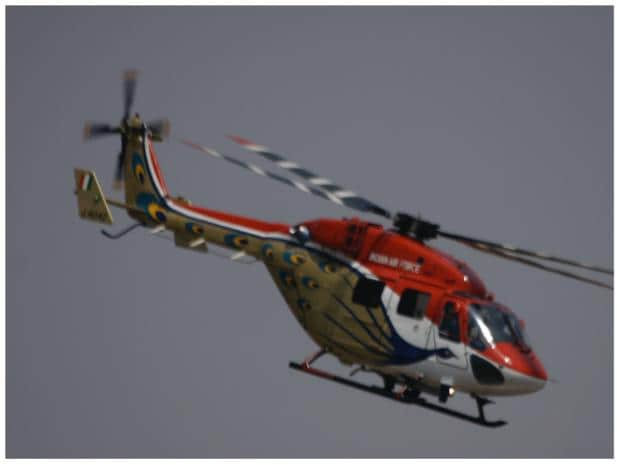[ad_1]
In 2016, Prime Minister Narendra Modi laid the foundation stone of Hindustan Aeronautics Limited’s (HAL’s) new helicopter manufacturing facility in Tumakuru, Karnataka. On Monday, Modi will dedicate the factory to the nation.
“The Greenfield helicopter factory, spread across 615 acres of land, is planned with a vision to become a one-stop solution for all helicopter requirements of the country. It is India’s largest helicopter manufacturing facility and will initially produce Light Utility Helicopters (LUHs),” stated the Ministry of Defence (MoD) on Saturday.
The LUH is an indigenously designed, three-tonne, single-engine, multipurpose, utility helicopter.
“Initially, this factory will produce around 30 helicopters per year and can be enhanced to 60 and then 90 per year in a phased manner. The first LUH has been flight-tested and is ready for unveiling, said the MoD.
In fact, HAL’s ambition for the Tumakuru plant extends well beyond the LUH to an entire ecosystem of home-grown light helicopters.
“The factory will be augmented to produce other helicopters such as Light Combat Helicopters (LCHs) and Indian Multirole Helicopters (IMRHs). It will also be used for maintenance, repair and overhaul of LCH, LUH, Civil Advanced Light Helicopter (ALH) and IMRH (Indian Multi-Role Helicopter) in the future. Potential exports of [a civil version of the LUH] will also be catered to from this factory,” said the MoD.
HAL plans to build more than 1,000 helicopters in the range of 3-15 tonnes, generating business of over Rs 4,00,000 crores over the coming two decades.
Besides generating employment, the Tumakuru facility will boost the development of surrounding areas through its CSR activities, says the MoD.
With facilities like a heli-runway, flight hangar, final assembly hangar, structural assembly hangar, Air Traffic Control and various supporting service facilities, the Tumakuru factory is fully operational. The MoD says it will enable India to design, develop and manufacture its entire requirement of helicopters indigenously, boosting the Prime Minister’s vision of ‘Aatmanirbhar Bharat’ (self-reliant India).
While only a dozen LUHs are presently cleared for purchase, the Indian Air Force (IAF) and the army will need 400 light utility helicopters to replace their obsolescent Cheetah and Chetak helicopters. Towards this, New Delhi and Moscow signed an “inter-government agreement” (IGA) in 2015 to jointly build 200 Kamov-226T light helicopters. Meanwhile, HAL will build and supply 200 LUHs.
However, India and Russia have sharp disagreements over work-share issues in building the Kamov-226T. If those are not resolved, HAL could end up building all 400 LUHs the military requires. The LUH could also capture sizable export orders.
Another helicopter success story came on October 3, 2022, when the Light Combat Helicopter (LCH), named Prachanda, was cleared to enter service. The Union Cabinet has approved the procurement of 15 LCHs for Rs 3,887 crore, or about Rs 260 crore each. Beyond this preliminary order, the MoD has projected a requirement for 162 LCHs: 65 for the IAF and 97 for the army. This will bring HAL an income stream of over ~ Rs 42,120 crore.
Such orders are set to increase the share of helicopters in HAL’s revenue stream. HAL’s record revenue, which exceeded ~ Rs 24,000 crore last year, came from the production of 44 helicopters/aircraft, 84 new engines, and the overhauling of 203 aircraft/helicopters and 478 engines.
Since the early-2000s, when HAL began assembling the Sukhoi-30MKI in Nashik, most of its income has come from fighter aircraft. With the Sukhoi-30s delivered, the MoD cleared a ~ Rs 46,898 crore order, in March 2020, for 83 Tejas Mark-1A fighters.
The Shakti success story
HAL’s helicopter successes — the Light Utility Helicopter (LUH); the Dhruv advanced light helicopter (ALH), the Rudra attack helicopter and the Light Combat Helicopter (LCH) – all have a common feature: the remarkable Indo-French Shakti engine, which is powerful enough to propel a helicopter to the dizzying heights of the Saltoro Ridge above the Siachen Glacier, where the Indian Army is deployed in posts like Sonam and Bana Top, at altitudes above 20,000 feet.
Infantrymen at those oxygen-deprived altitudes cannot carry heavy weaponry for long distances. However, a high-altitude attack helicopter can provide them with fire support, using its onboard, 20-millimetre turret gun, 70-millimetre rockets, air-to-air missiles and anti-tank guided missiles.
For the soldiers at these posts, a helicopter’s arrival could spell the difference between freezing or warmth; casualty evacuation or pulmonary failure – effectively between life or death.
To enable its light helicopters to operate at those altitudes, HAL and Safran Helicopter Engines together developed the Shakti engine, which powers HAL’s Dhruv, Rudra and Prachanda helicopters. The Ardiden 1U variant of the Shakti powers the new LUH. HAL says more than 500 Shakti engines have already been produced.
On July 8, 2022, HAL and Safran created a new joint venture that will develop helicopter engines for India’s future needs.
[ad_2]
Source link



